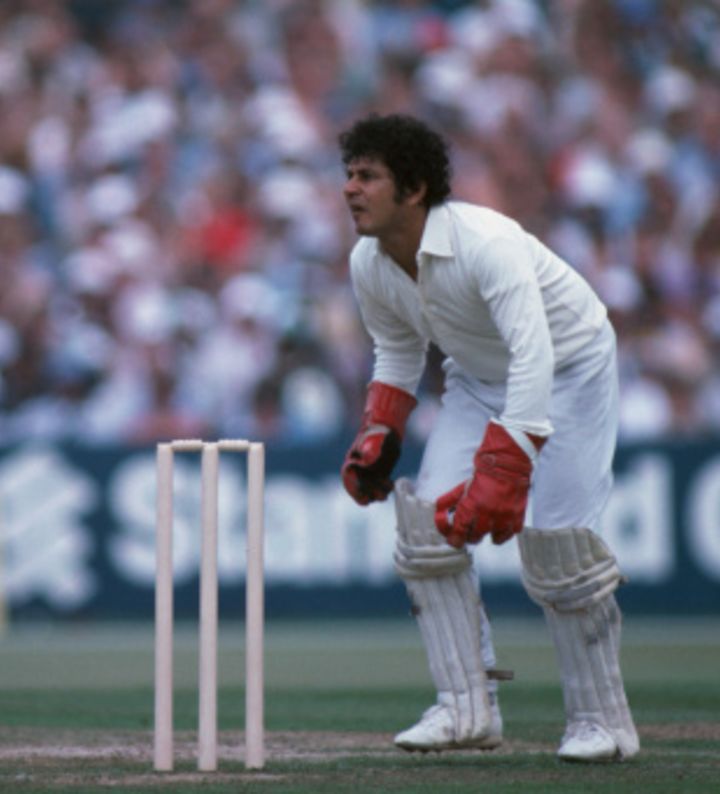An un-watchful nightwatchman, and big losers
Also: best figures and a pair, most no-balls in a Test, keeper's catches, and when WG graced Trent Bridge

I've heard that Robin Marlar of Sussex once went in as nightwatchman in a county match and was stumped second ball for 6. Did this really happen?! And has it ever happened to anyone in a Test? asked Lionel Jackson from England
I think this famous incident must have taken place in the end-of-season match between Surrey, the county champions, and The Rest at The Oval in September 1955. Robin Marlar went in as nightwatchman for The Rest towards the end of the first day, and was stumped by Arthur McIntyre off Tony Lock for 6. Wisden doesn't specifically mention that it was his second ball, but the Times did observe that "Marlar, the least watchful of watchmen one would have thought, [was] found wanting in his nocturnal duties." The only instance I can find of a batsman being out second ball for 6 in a Test was, oddly enough, not long before: it was the West Indian fast bowler Frank King, in the second innings of the fifth Test against Australia in Kingston in June 1955. The bowler was Australia's captain, Ian Johnson. Pat Landsberg's tour account states: "King survived two balls, the first of which he hit out of the ground and the second of which he neatly chipped into Archer's hands at slip."
Who has played the most Tests, and the most one-day internationals, without winning any? asked Jeremy Smith from England
Top of the Test list is the unfortunate New Zealander Bert Sutcliffe, who played 42 matches between 1949 and 1965 without ever finishing on the winning side - New Zealand did win a couple of Tests during his career, but he managed to miss those particular games. Next come Bryan Strang of Zimbabwe (26 Tests, no wins), Bangladesh's Shahriar Nafees (24), and Barry Sinclair of New Zealand (21). Three Bangladeshis lead the way in one-day internationals: Al Sahariar played 29 without ever winning one (27 defeats and two no-results), Sanwar Hossain 27 (25 defeats) and Hannan Sarkar 20 (19 defeats). Next comes Malachi Jones of Bermuda, who ended up on the losing side in all 12 of his ODIs. Three people have played 11 ODIs without ever winning one: Travis Dowlin of West Indies, Roland Lefebvre of the Netherlands, and Alester Maregwede of Zimbabwe.
Who has got the best bowling figures in a Test in which he bagged a pair with the bat? asked Waqas Chowdhury from India
The answer to this bittersweet question is the Surrey and England bowler George Lohmann, who took 15 wickets for 45 runs - 7 for 38 and 8 for 7 - but also bagged a pair against South Africa in Port Elizabeth in 1895-96. There are ten other instances of a player taking ten or more wickets in a Test but also bagging a pair, two of them by Muttiah Muralitharan.
What is the most no-balls by one bowler in a Test match? Was it by Wasim Akram? asked Khalid Murtaza from Lahore
Wasim Akram is quite high on this particular list - he bowled 25 no-balls against New Zealand in Christchurch in 1993-94, 24 against South Africa in Johannesburg the following season, and 21 against Zimbabwe in Peshawar in 1998-99, giving him three entries in the top eight. But the known record for no-balls in a Test is 26, by Sri Lanka's Champaka Ramanayake - later a noted bowling coach - against Australia in Colombo in 1992-93. It was costly - Sri Lanka conceded 90 extras in all in that match, which Australia (who conceded only 30) ended up winning by just 16 runs. It should be said that we don't have precise records for many early matches, but I think it's unlikely anyone has bowled more than 26.
When was the first instance of the wicketkeeper taking seven catches in a Test innings? asked Andy from England
I think this is a bit of a sneaky one, as the first instance of this involved two men: for Pakistan against West Indies in Kingston in 1976-77, Majid Khan stepped in for the injured Wasim Bari, who had been hit in the face while batting, and took four catches in the second innings; then Wasim returned later and held on to three more. Since then there have been four instances of a wicketkeeper taking seven catches in an innings. The first was by Wasim Bari (on his own this time) against New Zealand in Auckland in 1978-79, and he has been followed by Bob Taylor (England v India in Bombay, 1979-80), Ian Smith (New Zealand v Sri Lanka in Hamilton, 1990-91) and Ridley Jacobs (West Indies v Australia in Melbourne, 2000-01).
What event in 1871 caused Trent Bridge to be "thronged on the Monday and Tuesday to an extent it had never before been thronged"? asked Brian Appleby via Facebook
This was the occasion of the great WG Grace's first match at Trent Bridge - for Gloucestershire against Nottinghamshire in August 1871. WG top-scored in both innings, with 79 and 116, but both times the other batsmen struggled and Grace's contribution was over half the eventual total. Nottinghamshire batted much more solidly to make 364, and needed only one run in the second innings to win by ten wickets. The "thronging" quote is from the 1872 Wisden.
Steven Lynch is the editor of the Wisden Guide to International Cricket 2013. Ask Steven is now on Facebook
Read in App
Elevate your reading experience on ESPNcricinfo App.